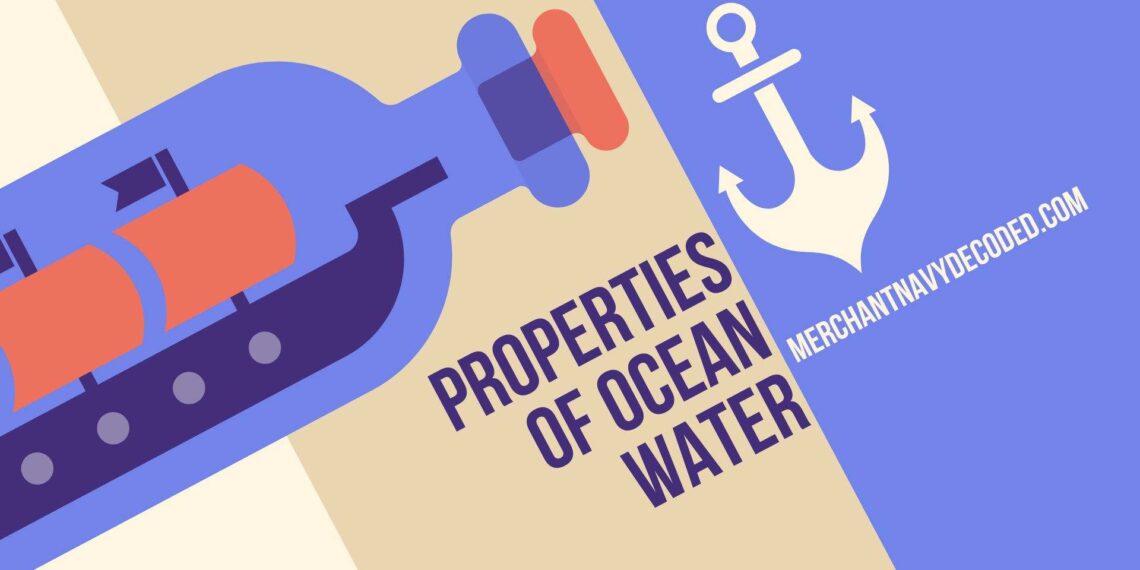Properties of Ocean Water
Ocean water is a vital planet component, influencing weather patterns, climate, and marine ecosystems. Understanding the properties of ocean water not only helps us appreciate the beauty and complexity of the seas but also underlines its importance in the global water cycle. The vast majority of Earth’s surface is covered by oceans, which are home to diverse marine life and have a critical role in the global distribution of water.
2:- Global Distribution of Ocean Water

Water spreads around our planet Earth via ocean currents covering about 71% of the Earth’s surface.
- Saltwater: Over 97% in the form of oceans.
- Freshwater: Only 3%, within which:
- About two-thirds is found in the form of Glaciers and Icecaps.
- About a third is found in the form of Groundwater.
- The rest of the freshwater is found in lakes, rivers, ponds, soil moisture, and water vapor in the atmosphere.
3:- Why Ocean Waters Important?
The significance of Ocean Water are as follows:
- Weather and Climatic Regulation: helps in regulating the earth’s climate as it absorbs 98% of heat produced by the sun’s rays, then this heat is disturbed around the earth via wind and water currents to move the warm water at the equator around the planet also to the two poles.
- Oxygen to breathe: The ocean produces about 50% of the oxygen we breathe.
- Biodiversity: The ocean is the home to copious lives. Some are discovered and others are not about which no one knows with certainty what that actual number is.
- Food: Ocean provides food for different species. It is one of the important sources of Protein for many people around the world.
- Transportation and Jobs: Acts as a significant resource for Transportation, about 90% of the world’s trade counts on sea routes. Oceans provide jobs to millions of people around the world. The share of those jobs is likely to include the fisheries sector, and transportation, followed by tourism.
4:- Most Fundamental Properties of Ocean Water
The following table will provide the technical details of ocean water so you can look at it from a glance. Other Properties are explained later
| Property | Value | Unit of Measurement |
| Salinity | 35 | PSU (Practical Salinity Units) |
| Temperature Varies | (typically 0°C to 30°C) | Degrees Celsius |
| Density | 1.025 | g/cm³ (at surface) |
| pH | 8.1 | |
| Conductivity | 4.8 S/m | (Siemens per meter) |
| Nutrient Content | Varies (Nitrate, Phosphate, Silicate) | µmol/L |
| Turbidity | 0.1-10 NTU | (Nephelometric Turbidity Units) |
| Light Penetration | 200-1,000 meters | (varies with location and time |
| Pressure | Increases with depth (1 atm per 10 meters depth) | atm (atmospheres) |
| Chlorophyll-a | Varies (0.01-2.0) | mg/m³ |
| Alkalinity | 2.3-2.5 meq/L | (milliequivalents per liter) |
5:- Salinity
Salinity refers to the abundance of dissolved salts in water. As a measure of the saltiness of seawater, it is usually taken in practical salinity units of parts per thousand (ppt). Typical seawater salinity is about 35 ppt. However, due to high evaporation in the Red Sea, for example, a higher salinity may be exhibited. On the other hand, voluminous river outflows in coastal environments result in decreased salinity.
Impact on Marine Life: Different marine organisms thrive at varying salinity levels, influencing biodiversity in different oceanic zones.
To learn more about salinity, visit NOAA’s Salinity Overview
6:- Temperature
Ocean water temperature changes, both vertically and horizontally depending on how close one is to the Equator. Oceans are warmer at the surface layers and at deeper levels away from the midsection. Temperature is significant to marine organisms because different types of organisms are adapted to live only in certain temperature conditions.
Tropical Coral Species: Need warmer water temperatures to survive.
Polar Species: Cod fishes are comfortable in cold waters while most fish are not.
Additionally, sea surface temperature impacts the climate of the entire planet and most of its weather systems including weather events such as El Nino and La Nina.
7:- Seawater Density
Density is another important characteristic of seawater which is dependent on temperature and salinity. It is a well-known fact that saltier, colder water is heavier than fresher, warmer water. As a consequence of the density difference, the ocean’s vertical layers get stratified, interfering with water movement, distribution of marine life and circulation, as well as the ecosystem and weather patterns of the Earth.
8:- Seawater pH Levels
The pH of seawater is about 7.5 and 8.5, so it is quite alkaline. pH also has an effect in this way that if there are some specific changes in pH it may spoil the chemical equilibrium of the ocean and some organisms especially ones with calcium carbonate shells and skeletons
9:- How Fundamental Properties drive Ocean Currents?

Two primary types of oceanic currents arise from salinity, thermohaline circulation, and density gradients.
Surface Currents: The surface circulating systems are mainly due to winds, although water salinity and temperature also contribute to the development of the currents. In the upper layer, water with high temperature and low density flows while cold, denser water is in the downward flow turbidity.
Deep Water Currents: It follows that deep water currents result from density gradients and are part of a global thermohaline circulation which is a style of ocean currents. These deep cold currents are believed to play a significant role in climatic changes for periods measured in years mostly because they transport dense, cold water from the polar region it the deep sea.
10:- Other Essential Properties of Ocean water
10.1:- Dissolved Oxygen and Marine Life
The presence of dissolved oxygen (DO) is critical for the life of plants and animals in the water. It is affected by regression analysis. Although sufficient oxygen levels are favorable and support strong and varied coastal ecosystems, low DO levels (hypoxia) creates dead zones or places where there is no life.
10.2:- Nutrient Content
Seawater contains essential nutrients including nitrogen, phosphorus, and silicates, which promote primary production such as phytoplankton growth. The productivity of marine habitats is in turn determined by these nutrients. However, too much of nutrients is also sometimes a curse and can trigger eutrophication.
10.3:- Light Penetration and its Role
Seawater contains particles and water that absorb and scatter light, so the penetration of light into the body of water decreases with depth. Sunlight is vital for marine plants and phytoplankton – the base of the marine food web – within which photosynthesis occurs. The growth of these photosynthetic organisms is limited to the photic zone or the stratum in the water column in which light is short.
10.4:- Turbidity
Turbidity is the term used for the degree to which seawater is hazy or cloudy as a result of the presence of suspended solids like silt, plankton, and organic matter. Excessive turbidity use prevents light from passing through, which serves as an obstacle to photosynthesis and the visibility of the ocean’s inhabitants. The feeding and breeding patterns of the aquatic species may also get affected as well.
11:- Conclusion
Ocean water is essential to maintaining Earth’s climate, supporting marine ecosystems, and providing resources for humans. From regulating global temperatures to sustaining life below and above water, understanding its properties is vital for preserving the health of our planet. Protecting the oceans and their properties ensures a stable future for generations to come.
Disclaimer :- The opinions expressed in this article belong solely to the author and may not necessarily reflect those of Merchant Navy Decoded. We cannot guarantee the accuracy of the information provided and disclaim any responsibility for it. Data and visuals used are sourced from publicly available information and may not be authenticated by any regulatory body. Reviews and comments appearing on our blogs represent the opinions of individuals and do not necessarily reflect the views of Merchant Navy Decoded. We are not responsible for any loss or damage resulting from reliance on these reviews or comments.
Reproduction, copying, sharing, or use of the article or images in any form is strictly prohibited without prior permission from both the author and Merchant Navy Decoded.



